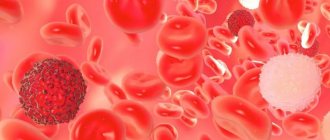Lung cancer is one of the most common types of cancer. Malignant lung tumors are difficult to treat because they are difficult to detect at an early stage. The disease is asymptomatic for a long time. Lung cancer in the photo looks like a space-occupying formation. It is prone to an aggressive course, metastasizes early and relapses.
Doctors at the Oncology Clinic of the Yusupov Hospital diagnose malignant lung tumors using modern equipment from leading companies in the USA and European countries. Professors and doctors of the highest category provide complex therapy, which includes surgery, radiation and chemotherapy. If there is a tumor in both lungs, the prognosis is less optimistic. If lung cancer is detected at an early stage, recovery occurs in 90% of patients.
Symptoms of lung cancer
After clinical examination in our country became much less popular, malignant neoplasms of the lungs increasingly began to be detected at later stages. In this case, lung cancer is often diagnosed accidentally - during an X-ray of the lungs during an examination for another disease.
If you do chest fluorography every year, in most cases the diagnosis can be made at earlier stages, when the prognosis looks most optimistic.
This is especially important because there are practically no symptoms due to which one can suspect oncology at an early stage. How lung cancer manifests depends on various factors: the stage of development of the tumor, its location in the lung, the disorders it causes, etc. Lung cancer can masquerade as various diseases. For example, sometimes it looks like long-term pneumonia that is difficult to treat. A growing tumor can cause coughing, secretion of mucous or mucopurulent sputum. Sometimes there is an admixture of blood in the sputum - this happens when the mucous membrane of the affected bronchus becomes inflamed. Such patients experience chest pain, shortness of breath, and hoarseness.
Due to the fact that the tumor releases harmful substances, other symptoms of lung cancer arise, which can be mistaken for manifestations of completely different diseases. These are fatigue, decreased ability to work, weakness, fever (usually slight), and weight loss.
Pancoast tumor symptoms
Cancer of the apex of the lung (Pancoast tumor), due to the close proximity of other organs and nerve trunks, often causes more pronounced symptoms: weakness of the muscles of the hand, pain in the shoulder girdle, along the front surface of the chest and between the shoulder blades, and discomfort also occurs in the area of the hand or forearm or sensitivity is impaired, muscles atrophy. Unfortunately, such symptoms often disorient the doctor, and the person wastes time treating non-existent cervicothoracic osteochondrosis.
Can this be avoided? Yes. It is enough to pay attention to Horner's syndrome. Due to damage to the cervical sympathetic ganglia, the upper eyelid of one eye droops (ptosis), one pupil narrows (miosis), and sweating significantly decreases on only one side of the face (anhidrosis). A person's voice may also become hoarse due to damage to the recurrent laryngeal nerve.
Symptoms of peripheral lung cancer
Peripheral lung cancer can be mistaken for sluggish pneumonia, which cannot be controlled with antibiotics, and the temperature usually rises to low levels.
In rare cases, paraneoplastic syndrome may indicate that a tumor has appeared or has begun to appear in the body. This is a complex of various manifestations that arise not due to the direct effect of the tumor on the tissue, but through the production of various substances by cancer cells. In lung cancer, more often than in any other cancer, paraneoplastic syndrome affects the nervous system. This, in particular, is manifested by difficulties in walking, lack of coordination, problems with maintaining balance, such a person becomes difficult to swallow, and his speech is slurred. In addition, deterioration in memory, sleep, vision, etc. may occur.
Paraneoplastic syndrome sometimes involves elevated calcium levels. In some cases, the tumor can even produce hormones that in a healthy body are synthesized by the pancreas and parathyroid glands, pituitary gland and hypothalamus. That's why your doctor should pay special attention to warning signs in order to conduct an in-depth examination and possibly detect lung cancer at an early stage.
Usually the first symptom of the disease is a persistent dry cough. If it bothers you for several weeks and is not associated with allergic or infectious diseases, you need to visit a doctor and get examined. Another early sign is an increase in body temperature. Usually it is insignificant, up to 37.5 degrees, but persists for a long time. Nonspecific symptoms such as increased fatigue, weakness, and frequent ailments are of concern. Often these manifestations are attributed to bronchitis and pneumonia.
Whistling sounds occur during breathing, and the voice becomes hoarse. Over time, the cough becomes more and more painful, during which sputum is released, in which an admixture of blood can be seen. This is definitely a reason to be screened for lung cancer.
There are no pain receptors in lung tissue. Therefore, in the early stages there will be practically no pain. They occur periodically and pass quickly. Later, when the tumor has time to grow significantly and spread into the pleura and intercostal nerves, long-term painful pain in the chest occurs. They can spread to the shoulder, the outer part of the arm.
The appearance of shortness of breath indicates that the tumor affects a large amount of lung tissue, due to which the respiratory surface is reduced. This symptom may be associated with exudative pleurisy.
Write to the oncologist
Maintenance therapy
There are situations when a patient cannot be subjected to chemotherapy and surgery. Then special treatment is prescribed that can significantly alleviate his condition and also prolong life. Such cases are not uncommon when diagnosing the last stage of lung carcinoma. In such situations, the patient can undergo all the procedures, selected individually:
- psychological assistance;
- relief of symptoms;
- blood transfusion;
- anesthesia;
- detoxification.
Types of lung cancer
To determine the prognosis and choose a treatment method, the doctor needs to know the histological structure of the tumor. To do this, a biopsy of the bronchi or lung is performed, that is, a small piece of tissue is taken during bronchoscopy (examination of the inner surface of the trachea and bronchi using special optical instruments) or thoracoscopy (examination of the pleural cavity through a puncture of the chest wall). After this, a specially processed and stained tissue sample is examined under a microscope and the type of tumor is determined. It is important to have “glasses” and “blocks” with tissue samples with you if you decide to seek a consultation at another clinic, so that they can look at them themselves and form their own opinion.
Depending on the type of cells there are:
- small cell carcinoma (oat cell, combined oat cell, intermediate cell);
- squamous cell or epidermal lung cancer (poorly differentiated, keratinizing, non-keratinizing);
- lung adenocarcinoma (acinar, papillary, bronchiolo-alveolar cancer, solid cancer with mucin formation);
- large cell carcinoma (giant cell, clear cell);
- glandular squamous cell carcinoma;
- cancer of the bronchial glands (adenocystic, mucoepidermoid, etc.).
There are also other, rarer types of lung cancer - there are at least twenty of them in total. One tumor can contain different types of cells. If there are metastases in the lungs, then the cells that make up them will look like the cells of the mother’s tumor.
In 40% of cases, malignant lung tumors are represented by adenocarcinomas, which are formed from cells that produce mucus. Lung adenocarcinomas predominantly occur in smokers or in people who once smoked. However, it is also the most common type of lung cancer in non-smokers. It is also one of the most common types of malignant tumors in young people.>
Adenocarcinoma is a relatively slow-growing malignant tumor. The chances of detecting it in the early stages are quite high. However, this is individual; in some patients this cancer behaves more aggressively.
To select the optimal treatment regimen for a patient with an atypical course of the disease, we use international databases, including cases from leading oncology clinics, results of medical research, and scientific articles. If doubts arise regarding the assessment of the histological analysis performed, we turn to our foreign colleagues: we scan images of histological sections and send them to a partner clinic. Within 2-5 days, we receive a second expert opinion with a histological report and a treatment plan option.
Thanks to scientific advances, it is possible to determine the sensitivity of a tumor to chemotherapy even before the start of treatment. Molecular analysis allows us to develop a more effective plan to combat lung cancer. At the European Clinic we use exactly this approach: it gives the best possible chance for treatment success.
Chemotherapy
The tactics of mass chemotherapy are determined by the form of the disease and the stage of carcinogenesis.
Common cytostatics are pharmacological drugs that have the ability to suppress the growth of cancer cells: Cisplatin, Etoposide, Cyclophosphamide, Doxorubicin, Vincristine, Nimustine, Paclitaxel, Carboplatin, Irinotecan, Gemcitabine. These drugs are used before surgery to reduce the size of the tumor. In some cases, the method has a good therapeutic effect. Side effects after using cytostatics are reversible.
Relatively recently introduced into practical use:
- hormonal treatments;
- immunological (cytokinetic) methods of combating lung cancer.
Their limited use is due to the complexity of hormonal correction of certain forms of cancer. Immunotherapy and targeted therapy do not effectively fight cancer in a body with a compromised immune system.
Consequences of chemotherapy
Side effects may include nausea, vomiting or diarrhea, and hair loss. Also, all the troubles are accompanied by ulcers on the oral mucosa, and there is a feeling of increased fatigue. Further, the hematopoietic function of the bone marrow suffers, leukocytes and hemoglobin decrease, and various types of infections can occur.
There are drugs that minimize side effects; they can prevent everything, including nausea. Before using chemotherapy drugs, it is better to cool the hair roots; this effect has a more than beneficial effect on them. After the medications are discontinued, the hair grows back and grows at an even faster rate than before.
As an adjuvant therapy in the treatment of lung cancer, ASD, which is a drug of natural origin. But before using this drug, consulting a specialist will not be superfluous, because, like any other drug, it has its contraindications. ASD 2 itself is used orally for the treatment of lung cancer, but local use is also possible.
Promising treatments for lung cancer
Radiation therapy
- Visually controlled radiation therapy to a cancer cell, or technology (IGRT). It consists of irradiating a damaged cell, instantly correcting it after sufficient exposure, and moving the load to an adjacent area of damaged tissue.
- Contact radiation exposure, or brachytherapy technology. It consists of delivering special substances to tumor tissues that enhance the targeted effect on damaged cells.
- Smart knife technology. The principle is the perfectly precise impact of the cyber-knife on a cluster of damaged cells.
Modern chemotherapy
- Marking of cancer cells (PDT technology) with substances that increase sensitivity to external laser action and eliminate damage to healthy tissue.
The main disadvantage of new technologies is that they affect the developed pathogenesis, but do not prevent pathological mutations.
Central and peripheral cancer
But when choosing a treatment, it is very important to consider not only the cell type: the location of the tumor is also of great importance. There are central and peripheral lung cancer. In central cancer, large bronchi are affected (main, lobar and segmental), while in peripheral cancer, smaller bronchi are affected.
In turn, there are four types of peripheral lung carcinoma:
- Subpleural node – this option also includes Pancoast tumor.
- Intralobar node.
- Diffuse and miliary forms.
- Cavity form.
In addition, mediastinal cancer is distinguished separately - these malignant tumors in the lungs are usually small in size, but quickly metastasize to the lymph nodes of the mediastinum.
Where the tumor grows is also an important factor when determining treatment tactics. If it grows into the lumen of the bronchus (exophytic cancer), it can partially or completely block the lumen. Then the development of secondary pneumonia is extremely likely. If the tumor grows into the thickness of the lung tissue (endophytic cancer), this does not affect the patency of the bronchial tube for quite a long time. Branched cancer is also found - the tumor is located around the bronchus and evenly narrows the lumen. To finally get an idea of the nature of tumor growth, you need to remove the tissue surgically and study it.
Peripheral cancer comes in three main types:
- round or nodular tumor;
- pneumonia-like cancer - has no clear boundaries and symptoms resemble pneumonia;
- cancer of the apex of the lung (Pancoast tumor).
There are also atypical forms that have different features of metastasis. To estimate the prevalence of lung cancer, the TNM classification system is used worldwide. Thanks to it, it is possible to systematize various clinical situations, determine treatment tactics, and also make a prognosis for the development of the disease - all this based on the anatomical characteristics of the tumor.
Is it possible to cure
How is lung carcinoma treated? Treatment must be carried out promptly. Otherwise, the malignant neoplasm will only increase. Therefore, the most important method of treatment is surgery. If the situation allows, then not only the tumor is removed, but also the lymph node and tissue located nearby are captured.
If surgical intervention is not possible, palliative methods are used, which can significantly alleviate the patient’s condition. If the moment is missed and distant metastases appear, then such methods of therapy are abandoned.
Small cell lung cancer
Small cell lung cancer is the most malignant of all. Such a tumor not only grows quickly, but also actively metastasizes. There are a number of other unpleasant features of this type of cancer.
- If the tumor grows inside the bronchus, it can cause atelectasis (“collapse” of part of the lung) and obstructive pneumonitis (inflammation) with cough, fever and chest pain.
- When the tumor disintegrates, there is a danger of pneumothorax - when air enters the pleural cavity (the sealed cavity between the layers of pleura that cover the surface of the lungs).
- If in the later stages the tumor, spreading, involves the pleura, this can cause hemothorax. In this condition, blood accumulates in the pleural cavity.
These situations are often extremely life-threatening, and it is often impossible to do without urgent surgical help.
Treatment
Standard treatments for lung cancer are:
- surgical removal of the tumor;
- Chemotherapy is the intravenous administration of chemical drugs that suppress the growth of tumor cells.
- Radiation therapy – exposure of altered cells to hard types of radiation.
Apply the above as a single method or in combination. Some forms, such as small cell carcinoma, are not amenable to surgery but are sensitive to chemotherapy.
Stages of lung cancer
The stage of malignant lung tumors is determined in accordance with the generally accepted TNM classification:
- The letter T indicates the size of the primary tumor. Next to it there may be symbols is, 1, 2, 3 and 4. Tis is a very small tumor that is located in the uppermost layers of the mucous membrane of the respiratory tract. T4 is a cancer that grows into neighboring organs.
- N – cancer has spread to nearby lymph nodes. N0 means that there are no lesions in the lymph nodes. Numbers 1, 2 and 3 characterize different degrees of lymph node involvement.
- M – presence of distant metastases. One of two numbers can be assigned to this letter: 0 – no distant metastases, 1 – distant metastases detected.
Stage classification differs slightly between non-small cell and small cell lung cancer. In NSCLC, depending on the characteristics of T, N and M, five stages are distinguished, they are designated by Roman numerals:
- Stage 0
: “cancer in situ”, with no lymph nodes involved and no distant metastases. This is the most favorable situation, characterized by the best prognosis for the patient. - Stage I
: the tumor is located only in the lungs, does not invade neighboring organs, lymph nodes are not affected, and there are no distant metastases. - Stage II
: Along with the primary tumor in the lungs, there are lesions in nearby lymph nodes. - Stage III
lesions in the lymph nodes of the mediastinum. This type of cancer is called locally advanced. - Stage IV
: The cancer has spread to both lungs, cancer cells are found in the fluid in the pleural cavity and pericardial cavity (the sac around the heart), or distant metastases are found.
For small cell lung cancer, the TMN system is also used, but in clinical practice the division into two stages is more important:
- Locally advanced
: the tumor is found on only one side, affecting only one part of the lung and nearby lymph nodes. - Extensive
: cancer has spread to other organs and there are distant metastases.
How to recognize lung cancer at an early stage?
When central lung cancer is at an early stage, it is very difficult to recognize. Examination by a therapist and x-ray examinations are ineffective. If such a person undergoes bronchoscopy with a biopsy, then the correct diagnosis can be made. Sometimes computed tomography helps to recognize the disease in the early stages.
If the cancer is peripheral, then it is impossible to do a biopsy, since it is simply not possible to get to the suspicious place using bronchoscopy. Therefore, a transthoracic needle biopsy is performed, that is, a piece of tissue is taken through a puncture in the chest wall. If lesions are in the mediastinum (the part of the chest cavity located between the sternum, spine, diaphragm, pleura and surfaces of the lungs), mediastinoscopy is performed (examination for the purpose of biopsy through an incision in the neck). Sometimes it is impossible to do without diagnostic thoracoscopy and thoracotomy (opening the chest cavity). To clarify how widespread the tumor is, a variety of diagnostic methods are used: ultrasound, bronchoscopy, multislice computed tomography, magnetic resonance and positron emission tomography, as well as radionuclide studies. Without this, it is impossible to choose the best approach to treating a particular patient.
Make an appointment with an oncologist
What increases the risk of developing lung cancer?
At the moment, the connection between lung cancer and smoking is not in any doubt. This is especially true for central squamous cell and large cell cancer: in 70–95 percent of cases, such patients smoked or smoke. The International Agency for Research on Cancer has concluded that smokers are 10 times more likely to develop lung cancer. Tobacco smoke contains a lot of carcinogenic substances. These are, in particular, polonium-210, polyaromatic hydrocarbons (naphthylamine, 2-toluidine, benzopyrene, 4-aminobiphenyl), nickel, a number of N-nitroso compounds, etc. The longer a person smokes, the higher his risks. In addition to smoking, some occupational factors also negatively affect the likelihood of developing lung cancer: for example, prolonged contact with asbestos and other hazardous substances. The likelihood of lung cancer also depends on air pollution with carcinogenic substances.
Prevention
Prevention of lung cancer includes the following recommendations:
- Quitting bad habits, primarily smoking;
- Maintaining a healthy lifestyle: proper nutrition rich in vitamins and daily physical activity, walks in the fresh air.
- Treat bronchial diseases in a timely manner so that they do not become chronic.
- Ventilation of the premises, daily wet cleaning of the apartment;
- It is necessary to reduce contact with harmful chemicals and heavy metals to a minimum. During work, be sure to use protective equipment: respirators, masks.
If you experience the symptoms described in this article, be sure to see a doctor for an accurate diagnosis.
Metastases to the lungs
Approximately every fifth patient with metastases in the lungs experiences cough, hemoptysis, shortness of breath, chest pain, low-grade fever, and weight loss. Often the occurrence of these symptoms indicates that the process has gone quite far. In most cases, metastases can be detected by X-ray examination, which is performed twice a year after treatment of the primary tumor. If metastases are found, a number of important studies must be carried out to choose the most appropriate treatment method. We are talking about computer, magnetic resonance and positron emission tomography of the chest organs, as well as bronchoscopy.
Basic diagnostic methods
First, the patient should see a doctor, who, after a thorough examination, will prescribe additional examination. At the moment, there are many methods to diagnose lung carcinoma. These include:
- bronchoscopy;
- X-ray examination;
- biopsy;
- cancer markers;
- ultrasonography.
Each method has its own characteristics. They are the ones who make it possible to determine the presence of oncological pathology at the initial stage of development. The main thing is to contact a specialist in time.











